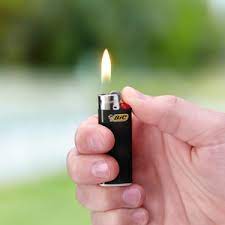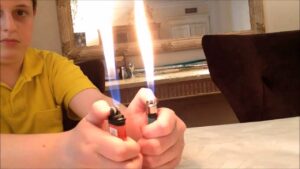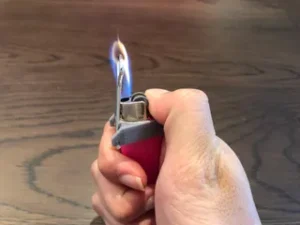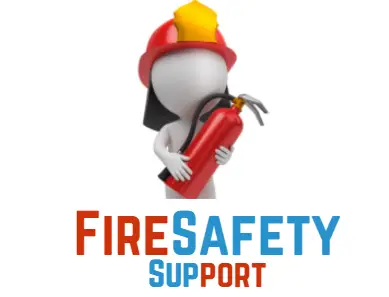Are you tired of struggling to light a fire or candle with a weak lighter flame? In this article, we’ll show you how to make a lighter flame bigger in just a few simple steps. From using the right fuel to adjusting the flame size, we’ve got all the tips and tricks you need to upgrade your lighter game.
To increase the size of a lighter flame, try holding the lighter farther from the flame, adjusting the gas flow, using a different fuel, using a different lighter, making sure the lighter is clean, or using a windproof lighter.
How to make a lighter flame bigger

There are a few different ways you can make a lighter flame bigger. Here are some steps you can follow to achieve this:
- Make sure that the lighter is full of fuel. If the lighter is running low on fuel, the flame will be smaller.
- Adjust the flame size dial or lever if your lighter has one. This will allow you to control the size of the flame.
- Hold the lighter closer to the object you are trying to ignite. The closer, the lighter is to the object, the larger the flame will be.
- Use a windproof lighter. These lighters are designed to stay lit in windy conditions, and the flame is typically larger as a result.
- If all else fails, you can try using a different type of lighter. Some lighters, such as torch lighters, have a much larger flame than traditional lighters.
Enhancing the flame output of a BBQ lighter
There are a few different ways you can try to enhance the flame output of a BBQ lighter:
- Make sure the lighter is properly filled with butane gas. If the lighter is not full, the flame will be weaker.
- Clean the burner nozzle. If the burner nozzle is clogged, it can restrict the flow of gas and result in a weaker flame. You can clean the nozzle by using a needle or a pin to gently remove any debris that may be blocking it.
- Adjust the flame control lever. Most BBQ lighters have a lever or dial that allows you to adjust the size of the flame. Try increasing the size of the flame by turning the lever or dial to a higher setting.
- Use a different lighter. If your current BBQ lighter is not producing a strong enough flame, you may want to try using a different lighter. Some lighters are designed specifically to produce a larger flame, and these may work better for your needs.
The science behind making a lighter flame larger
The flame size of a lighter is determined by the amount of gas and oxygen that is mixed and ignited within the burner nozzle.
When you press the ignition button on a lighter, the lighter’s mechanism releases a small amount of gas from the tank and mixes it with air in the nozzle. The spark from the ignition system then ignites the gas-air mixture, creating a flame.
To make the flame larger, you can try increasing the amount of gas that is mixed with the air in the nozzle. This can be done by adjusting the flame control lever or dial on the lighter, which allows more gas to be released when the ignition button is pressed.
You can also try using a lighter that is specifically designed to produce a larger flame, as these may have a larger fuel tank or a more powerful ignition system.
It’s also important to make sure that the lighter is properly filled with fuel and that the burner nozzle is not clogged, as these factors can also affect the size of the flame.
Using different fuels to create a bigger flame on a lighter
Most lighters are designed to use butane as fuel, and butane is generally the most suitable fuel for this purpose. Butane is a clean-burning, colorless gas that is easy to ignite and produces a stable, consistent flame. It is also readily available and relatively inexpensive.
However, it is possible to use other fuels in a lighter, although this is generally not recommended. Using a different fuel can result in a flame that is larger or smaller than normal, and it may also be less stable or more difficult to ignite. Some alternative fuels that have been used in lighters include propane, ethanol, and even gasoline.
It’s important to note that using a fuel other than butane in a lighter can be dangerous and may result in an explosion or fire. It can also damage the lighter and void any warranty that may be in place. It is generally best to stick with butane as the fuel for your lighter to ensure that it works safely and efficiently.
Tips for getting a larger flame from a lighter in cold weather

Cold weather can make it more challenging to get a larger flame from a lighter, as the lower temperatures can affect the performance of the lighter.
Here are a few tips for getting a larger flame from a lighter in cold weather:
1. Make sure the lighter is properly filled with fuel: If the lighter is low on fuel, the flame may be weaker. Be sure to fill the lighter with fresh, high-quality butane gas.
2. Keep the lighter warm: Cold temperatures can cause the gas in the lighter to vaporize more slowly, which can result in a weaker flame. To help keep the gas warm and vaporize more quickly, you can try keeping the lighter in a warm pocket or gloves when not in use.
3. Use a flame-enhancing tool: Some lighters come with a built-in flame-enhancing tool, such as a piezoelectric starter, which can help to create a stronger spark and ignite the gas more effectively in cold weather.
4. Use a different lighter: If your current lighter is not producing a strong enough flame in cold weather, you may want to try using a different lighter that is specifically designed for use in cold temperatures. These lighters may have a more powerful ignition system or a larger fuel tank to help produce a larger flame.
Adjusting the oxygen supply to make a lighter flame bigger
It is possible to adjust the oxygen supply in a flame to make it bigger, but it is important to be careful when working with flames and oxygen.
Adjusting the oxygen supply to a flame can affect the size and intensity of the flame. In general, increasing the oxygen supply to a flame will cause the flame to become bigger and burn more intensely.
This is because oxygen is a necessary component for the chemical reaction that occurs during combustion, and increasing the amount of oxygen available to the flame can cause the flame to burn more vigorously.
However, it is important to use caution when adjusting the oxygen supply to a flame, as increasing the oxygen too much can cause the flame to become too large and potentially dangerous. It is also important to ensure that the oxygen supply is properly regulated, as an unregulated supply can lead to an unstable flame.
In general, it is best to leave the oxygen supply to a flame as it is, unless you are specifically trying to make the flame bigger for a specific purpose and have the knowledge and equipment to do so safely.
Utilizing a fan or bellows to amplify the size of a lighter flame
Using a fan or bellows to amplify the size of a lighter flame can be an effective way to increase the flame’s size, as long as it is done safely.
A fan or bellows works by increasing the amount of oxygen that is available to the flame, which can cause the flame to burn more vigorously and become bigger.
To use a fan or bellows to amplify a lighter flame, you would simply need to aim the fan or bellows at the flame and use it to blow air toward the flame. This will increase the oxygen supply to the flame, causing it to burn more intensely and become bigger.
It is important to use caution when using a fan or bellows to amplify a flame, as increasing the oxygen supply to a flame too much can cause the flame to become too large and potentially dangerous. It is also important to ensure that the fan or bellows is properly regulated, as an unregulated flow of air can lead to an unstable flame.
In general, it is best to avoid using a fan or bellows to amplify a lighter flame unless you are specifically trying to make the flame bigger for a specific purpose and have the knowledge and equipment to do so safely.
Safety considerations when attempting to increase the size of a lighter flame

There are several safety considerations to keep in mind when attempting to increase the size of a lighter flame:
1. Use caution: Increasing the size of a lighter flame can be potentially dangerous, as flames can cause burns and start fires. Be sure to use caution when working with flames and follow proper safety protocols.
2. Use the appropriate equipment: If you are attempting to increase the size of a lighter flame using a fan or bellows, be sure to use equipment that is designed for this purpose and is in good working order.
3. Follow proper procedures: If you are using a fan or bellows to increase the size of a lighter flame, be sure to follow proper procedures for using this equipment. This includes properly regulating the flow of air and ensuring that the flame remains stable.
4. Keep flammable materials away: Be sure to keep flammable materials away from the flame when attempting to increase their size. This includes things like curtains, paper, and other items that could easily catch fire.
5. Have a fire extinguisher handy: It is always a good idea to have a fire extinguisher nearby when working with flames. If the flame gets out of control, you will be able to extinguish it to prevent any accidents quickly.
By following these safety considerations, you can help ensure that you are able to safely increase the size of a lighter flame.
The effects of wind on the size of a lighter flame
Wind can have a significant effect on the size of a lighter flame. In general, wind can cause a lighter flame to become larger or smaller, depending on the direction and intensity of the wind.
If the wind is blowing towards the flame, it can cause the flame to become larger by increasing the supply of oxygen to the flame. This is because wind can carry oxygen with it, and by blowing toward the flame, the wind can increase the amount of oxygen available to the flame, causing it to burn more intensely and become bigger.
On the other hand, if the wind is blowing away from the flame, it can cause the flame to become smaller by decreasing the supply of oxygen to the flame. This is because wind can carry oxygen away from the flame, reducing the amount of oxygen available to the flame and causing it to burn less intensely and become smaller.
Recommended:
Different types of lighters and their flame sizes
There are several different types of lighters that are available, and the size of the flame produced by each type of lighter can vary.
Some common types of lighters and the sizes of their flames include:
1. Disposable lighters: Disposable lighters typically produce small to medium-sized flames, depending on the specific brand and model.
2. Zippo lighters: Zippo lighters produce medium to large flames, depending on the fuel level and the age of the lighter.
3. Butane lighters: Butane lighters can produce a variety of flame sizes, ranging from small to large. The size of the flame produced by a butane lighter is often adjustable, allowing the user to control the size of the flame as needed.
4. Candle lighters: Candle lighters typically produce small to medium-sized flames, depending on the specific brand and model.
5. Grill lighters: Grill lighters produce large flames that are specifically designed for lighting grills and other outdoor cooking appliances.
The size of the flame produced by a lighter can be affected by a variety of factors, including the type of fuel being used, the design of the lighter, and the amount of oxygen available to the flame. In general, the size of the flame produced by a lighter can range from small to large, depending on the specific type of lighter and the conditions under which it is being used.
Conclusion
Are you in search of how to make a lighter flame bigger? You are just in the right place. There are several methods that can be used to make a lighter flame bigger, such as increasing the supply of oxygen, using a fuel with a high energy content, increasing the surface area of the fuel, using a wick, and adjusting the flame temperature.


